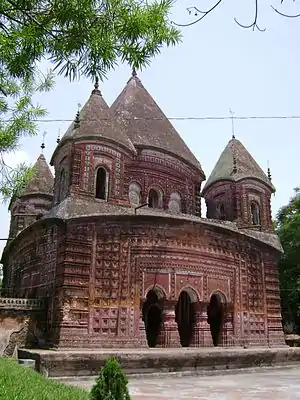| Pancha Ratna Govinda Temple | |
|---|---|
 Pancha Ratna Govinda Temple in Rajshahi, Bangladesh | |
| Religion | |
| Affiliation | Hinduism |
| Location | |
| Location | Puthia, Rajshahi |
| Country | Bangladesh |
| Architecture | |
| Completed | Between 1823 and 1895 |
The Pancha Ratna Govinda Temple (Bengali: পঞ্চরত্ন গোবিন্দ মন্দির) in Puthia village, Rajshahi district in Bangladesh. The temple is a striking monument, which was built in the 19th century. It has the architectural feature of five ratnas or spires. It is located within the inner precincts of the Puthia Rajbari or palace.[1][2]
Location
The temple is in Puthia town which is 32 kilometres (20 mi) away by road from Rajshahi city;[3] the city is also a rail head and is on the Dhaka Rajashahi Highway.[4]
History
The temple, located in the inner precincts of the Rajbari, to the left of Govindabari or Mandirangan of Panch Ani palace, is reported to have been built between 1823 and 1895. It was built by one of the maharani (queens) of the Puthia Royal family.[2][5]
Features
The temple is large square edifice with five decorated ratnas or spires. The feature in the lower portion of the spires consists of ridges while the upper part is tapered upward.[1][5] It is built in brick masonry over a raised platform. The temple's interior has a square sanctum sanctorum (garbagriha), with four square chambers in the corners, narrow passages on all four sides and has cusped arched openings. The roof of the sanctum and the chambers is formed by semi-circular domes, while the roof over the passages is vaulted.[5] It has simple surface plastering but with fine detailing with red coloured terracotta patterns on all four outer walls.[2][5] It is said that the temple architecture was inspired by the Kantanaga Temple built about 100 years earlier. The terracotta designs are made in panels which have depiction of romantic scenes from the Hindu epics of Ramayana and Radha-Krishna episodes related to Krishna and Radha. The sanctum in the temple has a Krishna image which is worshipped by local Hindus.[2][5]
Gallery
 Pancharatna Gobinda Temple
Pancharatna Gobinda Temple.jpg.webp) Terracotta of the Temple
Terracotta of the Temple Mint-tree in the yard
Mint-tree in the yard
See also
References
- 1 2 Nazimuddin Ahmad (1990). Epic Stories in Terracotta: Depicted on Kantanagar Temple, Bangladesh. University Press. p. 107. ISBN 0836437721.
- 1 2 3 4 Stuart Butler (2008). Bangladesh. Ediz. Inglese. Lonely Planet. p. 117. ISBN 978-1-74104-547-5.
- ↑ Alam, Mahmamuda, Puthia temple complex: Developing tourism through architecture (PDF), BRAC University, archived from the original (pdf) on 17 Jan 2022, retrieved 11 May 2015
- ↑ Mikey Leung; Belinda Meggitt (2009). Bangladesh. Bradt Travel Guides. p. 301. ISBN 0836437721.
- 1 2 3 4 5 "Puthia Rajbari". Pancha Ratna Bara Govinda Mandir. Rajshahi University Web Page. Archived from the original on 18 May 2015. Retrieved 11 May 2015.